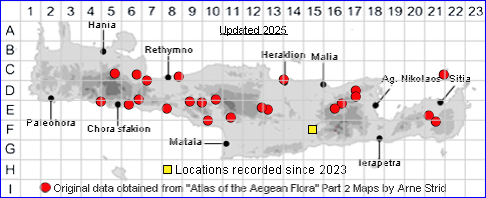
SPECIES DESCRIPTION
SILENE DICHOTOMA subsp. RACEMOSA
Family and Genus:- See- CARYOPHYLLACEAE/Sect. DICHOTOMAE
Common Names:- Forked catchfly
Homotypic Synonyms:- Silene dichotoma
Meaning:- Silene (Gr) A name used by the Greek philosopher Theophrastus for
catchfly.
Dichotoma (Gr) Divided equally into two, split into two.
Racemosa (L) Having racemose inflorescences.
General description:- Medium to tall, erect, short-lived, hairy, perennial.
Stems:-
1) 30-80 cm, arcuate, sparingly branched ± crispate-pubescent to villous
throughout; non-flowering shoots lacking.
Leaves:-
1) Rosette, spathulate, often withered at anthesis.
2) Cauline, obovate-lanceolate, 1-3 cm wide.
Flowers:-
1) White, rarely pale pink, 15-18 mm.
2) Inflorescence, lax, monochasial, with l(-2) dichasial branchings 5- to 10-flowered;
at the base.
3) Pedicels, short, deflexed at anthesis, straight and thickened at maturity.
4) Bracts, upper, small, ovate, margins ciliate.
5) Calyx, 7-15 mm, ovoid-oblong in fruit, not inflated, sparsely and shortly
pubescent between the veins, sparsely hispid on the veins; teeth ovate-
lanceolate, acute.
6) Petal-limb, 7-8 mm, bifid almost to the base.
7) Filaments, and styles very long-exserted.
8) Anthophore, 1-2 mm.
Fruit:-
1) Capsule, 6-9 mm, ovoid, firm.
2) Carpophore,1·5-4 mm, very stout, glabrous.
3) Seeds, 1.2-1.7 mm, grey, tuberculate, with acutely keeled shoulders.
Key features:-
1) Plant, hairy, at least in part.
2) Calyx, veins, sparsely hispid.
Habitat:- Grassland, dry open shrubby vegetation, rocky slopes and cliff ledges,
occasionally roadsides and olive groves. 0-1000 m.
Distribution:- C and E Mediterranean from Crete and Greece eastwards; casual
elsewhere. Limited distribution on Crete.
Flowering time:- Apr to early Aug.
Photos by:- Steve Lenton
